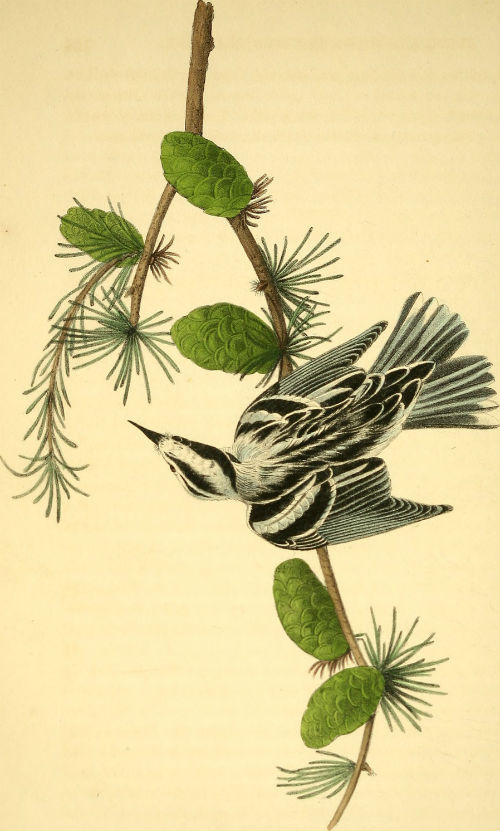
NEW YORK – Birds, to many, are like background music; always there yet barely heard. To enthusiasts, however, birds are a singular source of delight. Their aural or visual identification of black-capped chickadees (chick-a-dee-dee-dee) or American magpies (mag-mag-mag), for instance, may not just inspire recitals of their habits and habitats. It may even evoke spontaneous imitations of their calls.
Many fans, birds of a feather, maintain lists of all species they have sighted throughout their lifetimes. Moreover, millions, in the field or out, study the ever-growing body of birding books and guides. Scores, in addition, dream of owning an original, hand-colored print from the most monumental bird book of all, The Birds of America, by John James Audubon (1785-1851).
Although books about North American birds already existed, Audubon outdid them not only in scope and vision, but also in size. His Birds of America, which measures approximately 39 by 27 inches, nearly doubles the size of elephant folios. So it is dubbed a double-elephant folio. This masterwork features 435, hand-colored copperplate engraved prints that are derived from Audubon’s original paintings.

Unlike those who worked from taxidermed specimens, Audubon, after observing birds in the wild, wired-and-threaded freshly killed ones in lifelike, carefully constructed poses. Then quickly, before their feathers faded, he painted them in their natural surroundings. Rather than use conventional oils, he created his amazingly realistic images by combining watercolors and pastels with gouache, chalk and other mediums.
Audubon’s birds are not only life-like, but life-size. He posed some of the leggiest oddly, however, to fit his folios. His American Flamingo, for instance, dips gracelessly to drink, while the elegant, mostly motionless Great Blue Heron, is depicted angling awkwardly head-down, possibly in search of perch.

Each of Audubon’s entries, in addition, feature lengthy explanations and observations. “The Chuck-will’s-widow,” he writes, “ manifests a strong antipathy towards all snakes, however harmless they may be. Although these birds cannot in any way injure the snakes, they alight near them on all occasions, and try to frighten them away, by opening their prodigious mouth, and emitting a strong hissing murmur … ”
The Mottled Owl, he reveals, “on alighting, which it does plumply … immediately bends its body, turns its head to look behind it, performs a curious nod, utters its notes, then shakes and plumes itself, and resumes its flight, in search of prey.”

Audubon sold Birds of America plates to subscribers, at around $1,000 a set (about $19,000 in 2019 dollars) , from 1827 through 1838. Each, at intervals, received images of one large bird, one medium, and three small birds. Some eventually bound their entirety into four 50-pound volumes, symbols of wealth and social status. Since opening one required at least two people, many owners showcased these treasures permanently in massive, fine wood, custom-made cabinets or ottoman-like viewing constructions. Others, some say, to accommodate their expansive “wingspans,” moved to larger apartments.
From 1840 through 1844, Audubon produced a smaller, seven-volume, more affordable First Royal Octavo Edition of his masterpiece. Since its plates retain the same fine detail and quality as the originals (and include birds that he had since identified), they are extremely collectible. Five more octavo editions, some with new drawings, followed. Toward 1860, Audubon’s sons began reissuing a full-sized, second, chromo-lithographed Birds of America edition. Since disruptions, including the outbreak of the Civil War, halted its completion, its rare, surviving plates are particularly desirable.

Print dealers often break expensive, bound Audubon publications into more marketable, individual plates. Yet single, full-size, full-color, Double-Elephant Folio prints, like the Meadow Lark, may run thousands of dollars. Octavo prints, though smaller, newer and less prestigious, may also be quite costly.
Nonetheless, when Betsy, a lifelong bird lover with little cash to spare, entered a particularly enticing fine print shop, she decided to splurge on one of its least expensive prints – as long as its condition was very good, and she had actually seen the bird in the wild.

While paying for her choice, a Creeping Black-and-White Warbler, she remarked, “I guess this is the closest I’ll ever come to owning an Audubon.”
The salesman said, “You do own an Audubon.”
Each time she remembers, she gets emotional.


